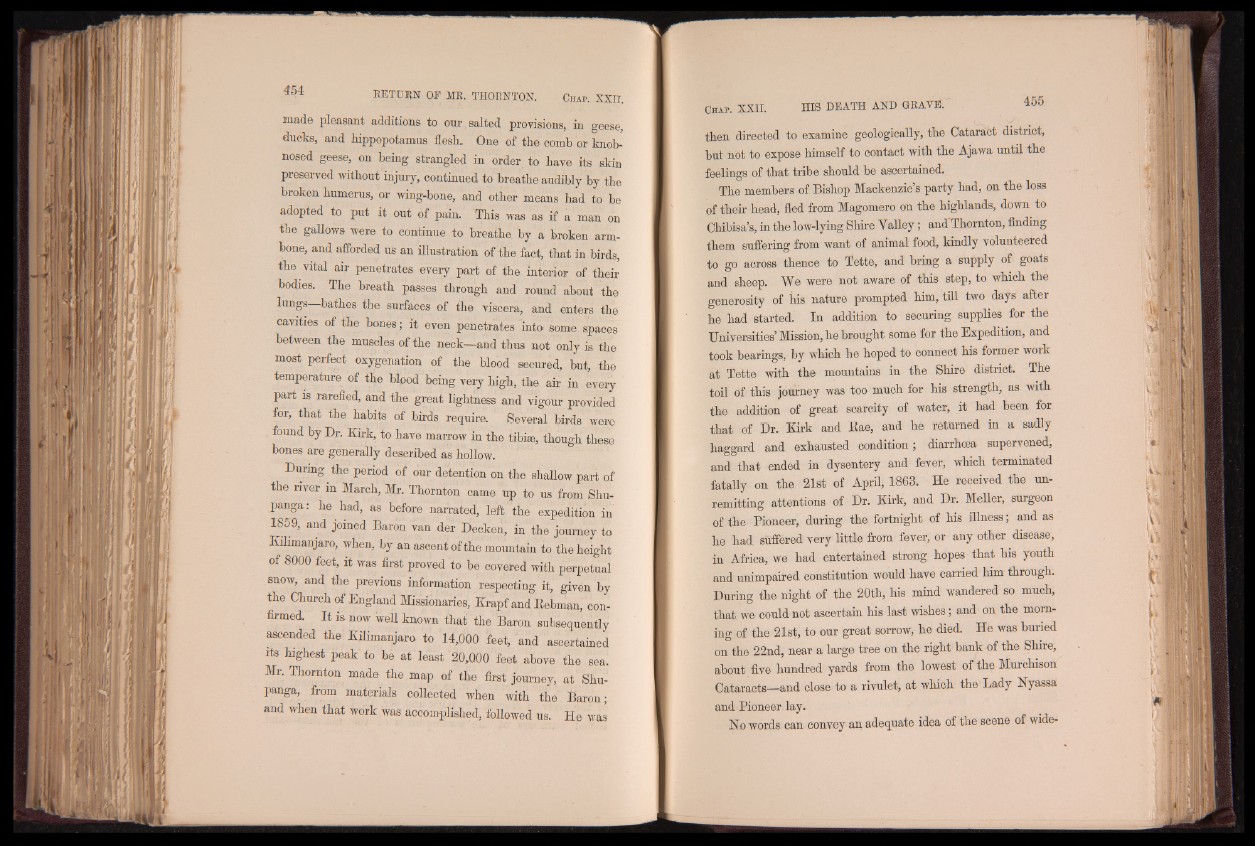
made pleasant additions to our salted provisions, in geese,
ducks, and hippopotamus flesh. One of the comb or knob-
nosed geese, on being strangled in order to have its skin
preserved without injury, continued to breathe audibly by the
broken humerus, or wing-bone, and other means had to be
adopted to put it out of pain. This was as if a man on
the gallows were to continue to breathe by a broken arm-
bone, and afforded us an illustration of the fact, that in birds,
the vital air penetrates every part of the interior of their
bodies. The breath passes through and round about the
lungs bathes the surfaces of the viscera, and enters the
cavities of the bones ; it even penetrates into some spaces
between the muscles of the neck—and thus not only is the
most perfect oxygenation of the blood secured, but, the
temperature of the blood being very high, the air in every
part is rarefied, and the great lightness and vigour provided
for, that the habits of birds require. Several birds were
found by Dr. Kirk, to have marrow in the tibiae, though these
bones are generally described as hollow.
During the period of our detention on the shallow part of
the river m March, Mr. Thornton came up to us from Shu-
panga: he had, as before narrated, left the expedition in
1859, and joined Baron van der Decken, in the journey to
Kilimanjaro, when, by an ascent of the mountain to the height
of 8000 feet, it was first proved to be covered with perpetual
snow, and the previous information respecting it, given by
the Church of England Missionaries, Krapf and Rebman, confirmed.
I t is now well known that the Baron subsequently
ascended the: Kilimanjaro to 14,000 feet, and ascertained
its highest peak to be at least 20,000 feet above the sea.
Mr. Thornton made the map of the first journey, at Shu-
panga, from materials collected when with the Baron;
and when that work was accomplished, followed us. He was
then directed to examine geologically, the Cataract district,
but not to expose himself to contact with the Ajawa until the
feelings of that tribe should be ascertained.
The members of Bishop Mackenzie’s party had, on the loss
of their head, fled from Magomero on the highlands, down to
Chibisa’s, in the low-lying Shire Valley; and Thornton, finding
them suffering from want of animal food, kindly volunteered
to go across thence to Tette, and bring a supply of goats
and sheep. We were not aware of this step, to which the
generosity of his nature prompted him, till two days after
he had started. In addition to securing supplies for the
Universities’Mission, he brought some for the Expedition, and
took bearings, by which he hoped to connect his former work
at Tette with the mountains in the Shire district. The
toil of this journey was too much for his strength, as with
the addition of great scarcity of water, it had been for
that of Dr. Kirk and Eae, and he returned in a sadly
haggard and exhausted condition; diarrhoea supervened,
and that ended in dysentery and fever, which terminated
fatally on the 21st of April, 1863. He received the unremitting
attentions of Dr. Kirk, and Dr. Meller, surgeon
of the Pioneer, during the fortnight of his illness; and as
he had suffered very little from fever, or any other disease,
in Africa, we had entertained strong hopes that his youth
and unimpaired constitution would have carried him through.
During the night of the 20th, his mind wandered so much,
that we could not ascertain his last wishes; and on the morning
of the 21st, to our great sorrow, he died. He was buried
on the 22nd, near a large tree on the right bank of the Shire,
about five hundred yards from the lowest of the Murchison
Cataracts—and close to a rivulet, at which the Lady Nyassa
and Pioneer lay.
Ho words can convey an adequate idea of the scene of wide